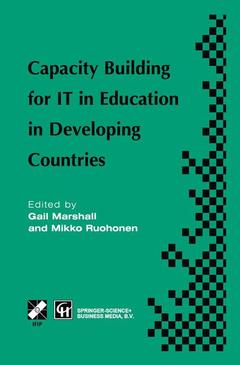Description
Capacity Building for IT in Education in Developing Countries, 1998
IFIP TC3 WG3.1, 3.4 & 3.5 Working Conference on Capacity Building for IT in Education in Developing Countries 19–25 August 1997, Harare, Zimbabwe
IFIP Advances in Information and Communication Technology Series
Coordinators: Marshall Gail, Ruohonen Mikko
Language: English
Subject for Capacity Building for IT in Education in Developing...:
Keywords
Administration; OLAT; communication; computer; learning; proving; tools
Publication date: 01-2013
360 p. · 15.5x23.5 cm · Paperback
360 p. · 15.5x23.5 cm · Paperback
Description
/li>Contents
/li>
Deryn Watson CapBIT 97, Capacity Building for Information Technologies in Education in Developing Countries, from which this publication derives, was an invited IFIP working conference sponsored by Working Groups in secondary (WG 3. 1), elementary (WG 3. 5), and vocational and professional (WG 3. 4) education under the auspices ofIFIP Technical Committee for Education (TC3). The conference was held in Harare, Zimbabwe 25th - 29th August 1997. CapBIT '97 was the first time that the IFIP Technical Committee for Education had held a conference in a developing country. When the Computer Society of Zimbabwe offered to host the event, we determined that the location and conference topic reflect the importance of issues facing countries at all stages of developmen- especially Information Technologies (IT) development. Information Technologies have become, within a short time, one of the basic building blocks of modem industrial society. Understanding IT, and mastering basic skills and concepts of IT, are now regarded as part of the core education of all people around the world, alongside reading and writing. IT now permeates the business environment and underpins the success of modem corporations as well as providing government with cost-effective civil service systems. At the same time, the tools and technologies of IT are of value in the process of learning, and in the organisation and management of learning institutions.
I National Perspectives.- 1 Nordic cooperation on communication and information technologies and didactics in education.- 2 Building resource capacity for IT education and training in schools — the case of Botswana.- 3 Computer education and human capacity for information technology in Namibia.- 4 Schools with SPIRIT — capacity building in The Netherlands.- 5 Information technology in Norwegian education — consistency of strategic initiatives implementing IT in primary education.- 6 Development of information technology in Hong Kong education over the past decade.- 7 Fighting a lone battle for computer education in Nepal.- II Building Skills in the National Context.- 8 Bridging the skills gap in Zimbabwe.- 9 Information technology education and training initiatives — the Nigerian experience.- 10 Using applications programs in a university to build human capacity for information technology.- III Targetted Projects.- 11 Infrastructure issues for implementation of portable computer use in schools.- 12 Capacity building with a difference.- 13 Principals, information technology and leadership — coping with professional development despite isolation.- 14 ‘Communicate and Learn’ — a collaborative project.- 15 The effect of network technology on education.- IV Classroom-based Initiatives.- 16 Technology and young children — new strategies to prevent illiteracy and create better chances of success for all.- 17 Designing Logo-based microworlds for effective learning — a road to improving teacher education.- V Research for IT-based Education.- 18 The needs and challenges of information systems education — the case of Nigerian universities.- 19 Blarne the technocentric artefact! What research tells us about problems inhibiting teacher use of IT.- 20 Measuringsuccess in the global village — resources for conducting systematic and comprehensive evaluations in IT settings.- VI Resource acquisition, allocation and utilization.- 21 The role of educational and professional bodies in guidance towards capacity planning.- 22 The European computer driving licence.- 23 Information literacy — the missing link in education, with special reference to developing countries.- 24 Maximizing the benefits of aid for information technology.- 25 Building capacity for information technology in educational management in developing countries.- 26 Information technology resources for education in developing countries.- VII A Curriculum for the Future.- 27 The need for a new perspective — creating learning networks for African teachers: change, professional development and ICTs.- 28 Informatics for secondary education — the UNESCO/IFIP curriculum as a resource for developed and developing countries.- VIII Workshop Presentations.- 29 Teaching informatics as a subject.- 30 Using hypermedia and the internez in the teaching of mathematics.- 31 Information technology and problem solving in mathematics education.- 32 Appropriate research in IT in emerging countries.- IX Discussion Group Recommendations.- Discussion Group 1 — IT in curriculum and courseware development.- 34 Discussion Group 2 — Policies, strategies and initiatives of ICT in education.- 35 Discussion Group 3 — Guidelines and directions for ICT policy in education.- 36 Discussion Group 4 — IT education delivery and learning.- 37 Discussion Group 5 — Information technology in institutional administration and management.- 38 Discussion Group 6 — Building resource accessibility in developing countries.- Alphabetical List of Participants.- Index of Contributors.- Keywordindex.
© 2024 LAVOISIER S.A.S.



